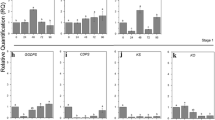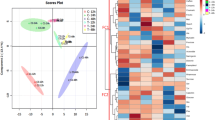Abstract
Exposure of cell suspension cultures of Medicago truncatula Gaerth. to methyl jasmonate (MeJA) resulted in up to 50-fold induction of transcripts encoding the key triterpene biosynthetic enzyme β-amyrin synthase (βAS; EC 5.4.99.-). Transcripts reached maximum levels at 24 h post-elicitation with 0.5 mM MeJA. The entry point enzymes into the phenylpropanoid and flavonoid pathways, l-phenylalanine ammonia-lyase (PAL; EC 4.3.1.5) and chalcone synthase (CHS; EC 2.3.1.74), respectively, were not induced by MeJA. In contrast, exposure of cells to yeast elicitor (YE) resulted in up to 45- and 14-fold induction of PAL and CHS transcripts, respectively, at only 2 h post-elicitation. βAS transcripts were weakly induced at 12 h after exposure to YE. Over 30 different triterpene saponins were identified in the cultures, many of which were strongly induced by MeJA, but not by YE. In contrast, cinnamic acids, benzoic acids and isoflavone-derived compounds accumulated following exposure of cultures to YE, but few changes in phenylpropanoid levels were observed in response to MeJA. DNA microarray analysis confirmed the strong differential transcriptional re-programming of the cell cultures for multiple genes in the phenylpropanoid and triterpene pathways in response to MeJA and YE, and indicated different responses of individual members of gene families. This work establishes Medicago cell cultures as an excellent model for future genomics approaches to understand the regulation of legume secondary metabolism.






Similar content being viewed by others
Abbreviations
- ABA :
-
Abscisic acid
- βAS :
-
β-Amyrin synthase
- CHS :
-
Chalcone synthase
- EST :
-
Expressed sequence tag
- MeJA :
-
Methyl jasmonate
- PAL :
-
l-Phenylalanine ammonia-lyase
- SA :
-
Salicylic acid
- TC :
-
Tentative consensus
- YE :
-
Yeast elicitor
References
Akalezi CO, Liu S, Li QS, Yu JT, Zhong JJ (1999) Combined effects of initial sucrose concentration and inoculum size on cell growth and ginseng saponin production by suspension cultures of Panax ginseng. Process Biochem 34:639–642
Barz W (1977) Degradation of polyphenols in plants and plant cell suspension cultures. Physiol Veg 15:261–277
Barz W, Mackenbrock U (1994) Constitutive and elicitation induced metabolism of isoflavones and pterocarpans in chickpea (Cicer arietinum) cell suspension cultures. Plant Cell Tissue Org Cult 38:199–211
Batz O, Logemann E, Reinold S, Hahlbrock K (1998) Extensive reprogramming of primary and secondary metabolism by fungal elicitor or infection in parsley cells. Biol Chem 379:1127–1135
Behboudi S, Morein B, VillacresEriksson MC (1999) Quillaja saponin formulations that stimulate proinflammatory cytokines elicit a potent acquired cell-mediated immunity. Scand J Immunol 50:371–377
Bestel-Corre G, Dumas-Gaudot E, Poinsot V, Dieu M, Dierick JF, van Tuinen D, Remacle J, Gianinazzi-Pearson V, Gianinazzi S. (2002) Proteome analysis and identification of symbiosis-related proteins from Medicago truncatula Gaertn. by two-dimensional electrophoresis and mass spectrometry. Electrophoresis 23:122–37
Blount JW, Masoud S, Sumner LW, Huhman DV, Dixon RA (2002) Over-expression of cinnamate 4-hydroxylase leads to increased accumulation of acetosyringone in elicited cell-suspension cultures. Planta 214:902–910
Broeckling CD, Huhman DV, Farag M, Smith JT, May GD, Mendes P, Dixon RA, Sumner LW (2004) Metabolic profiling of Medicago truncatula cell cultures reveals effects of biotic and abiotic elicitors on metabolism. J Exp Bot (in press)
Cook DR (1999) Medicago truncatula—a model in the making! Curr Opin Plant Biol 2:301–304
Dalkin K, Edwards R, Edington B, Dixon RA (1990) Stress responses in alfalfa (Medicago sativa L.) I. Elicitor-induction of phenylpropanoid biosynthesis and hydrolytic enzymes in cell suspension cultures. Plant Physiol 92:440–446
Dangl JL, Hauffe KD, Lipphardt S, Hahlbrock K, Scheel D (1987) Parsley protoplasts retain differential responsiveness to u.v. light and fungal elicitor. EMBO J 6:2551–2556
d’Erfurth I, Cosson V, Eschstruth A, Lucas H, Kondorosi A, Ratet P (2003) Efficient transposition of the Tnt1tobacco retrotransposon in the model legume Medicago truncatula. Plant J 34:95–106
Dixon RA (1999) Isoflavonoids: biochemistry, molecular biology and biological functions. In: Sankawa U (ed) Comprehensive natural products chemistry. Elsevier, Amsterdam, pp 773–823
Dixon RA, Fuller KW (1978) Effects of growth substances on non-induced and Botrytis cinerea culture filtrate-induced phaseollin production in Phaseolus vulgaris cell suspension cultures. Physiol Plant Pathol 12:279–288
Dixon RA, Sumner LW (2003) Legume natural products. Understanding and manipulating complex pathways for human and animal health. Plant Physiol 131:878–885
Dixon RA, Dey PM, Murphy DL, Whitehead IM (1981) Dose responses for Colletotrichum lindemuthianum elicitor-mediated enzyme induction in French bean cell suspension cultures. Planta 151:272–280
Dixon RA, Harrison MJ, Paiva NL (1995) The isoflavonoid phytoalexin pathway: from enzymes to genes to transcription factors. Physiol Plant 93:385–392
Goss V, Tusher VG, Tibshirani R, Chu G (2001) Significance analysis of microarray applied to the ionizing radiation response. Proc Natl Acad Sci USA 98:5116–5121
Hakamatsuka T, Shinkai K, Noguchi H, Ebizuka Y, Sankawa U (1992) Isoflavone dimers from yeast extract-treated cell suspension cultures of Pueraria lobata. Z Naturforsch Teil C 47:177–182
Haridas V, Higuchi M, Jayatilake GS, Bailey D, Mujoo K, Blake ME, Arntzen CJ, Gutterman JU (2001) Avicins: triterpenoid saponins from Acacia victoriae (Bentham) induce apoptosis by mitochondrial perturbation. Proc Natl Acad Sci USA 98:5821–5826
Hildmann T, Ebneth M, Peña-Cortés H, Sánchez-Serrano JJ, Willmitzer L, Prat S (1992) General roles of abscisic and jasmonic acids in gene activation as a result of mechanical wounding. Plant Cell 4:1157–1170
Howles PA, Sewalt VJH, Paiva NL, Elkind NL, Bate Y, Lamb CJ, Dixon RA (1996) Overexpression of l-phenylalanine ammonia-lyase in transgenic tobacco plants reveals control points for flux into phenylpropanoid biosynthesis. Plant Physiol 112:1617–1624
Huhman DV, Sumner LW (2002) Metabolic profiling of saponin glycosides in Medicago sativa and Medicago truncatula using HPLC coupled to an electrospray ion-trap mass spectrometer. Phytochemistry 59:347–360
Kessmann H, Choudhary AD, Dixon RA (1990) Stress responses in alfalfa (Medicago sativa L.) III. Induction of medicarpin and cytochrome P450 enzyme activities in elicitor-treated cell suspension cultures and protoplasts. Plant Cell Rep 9:38–41
Klessig DF, Malamy J (1994) The salicylic acid signal in plants. Plant Mol Biol 26:1439–1458
Kombrink E, Hahlbrock K (1985) Dependence of the level of phytoalexin and enzyme induction by fungal elicitor on the growth stage of Petroselinum crispum cell cultures. Plant Cell Rep 4:277–280
Kombrink E, Hahlbrock K (1986) Responses of cultured parsley cells to elicitors from phytopathogenic fungi. Timing and dose dependency of elicitor-induced reactions. Plant Physiol 81:216–221
Lee SJ, Ko WG, Kim JH, Sung JH, Lee SJ, Moon CK, Lee BH (2000) Induction of apoptosis by a novel intestinal metabolite of ginseng saponin via cytochrome c-mediated activation of caspase-3 protease. Biochem Pharmacol 60:677–685
Logemann E, Tavernaro A, Schulz WG, Somssich IE, Hahlbrock K (2000) UV light selectively coinduces supply pathways from primary metabolism and flavonoid secondary product formation in parsley. Proc Natl Acad Sci USA 97:1903–1907
Lu MB, Wong HL, Teng WL (2001) Effects of elicitation on the production of saponin in cell culture of Panax ginseng. Plant Cell Rep 20:674–677
Mathesius U, Keijzers G, Natera SHA, Winman JJ, Djordjevic MA, Rolfe BG (2001) Establishment of a root proteome reference map for the model legume Medicago truncatula using the expressed sequence tag database for peptide mass fingerprinting. Proteomics 1:1424–1440
May GD, Dixon RA (2004) Quick guide—Medicago truncatula. Curr Biol 14:R180–181
Mueller MJ, Brodschelm W, Spannagl E, Zenk MH (1993) Signaling in the elicitation process is mediated through the octadecanoid pathway leading to jasmonic acid. Proc Natl Acad Sci USA 90:7490–7494
Nosov AV, Globa EB, Kulichenko IE, Reshetnyak OV, Sobolkova GI (2000) Effect of 5-azacytidine, a tool for epigenetic control, on saponin synthesis in cell cultures of Dioscorea deltoidea and Panax quinquefolium. Russ J Plant Physiol 47:407–416
Oh SR, Kinjo J, Shii T, Ikeda T, Nohara T, Ahn KS, Kim JH, Lee HK (2000) Effects of triterpenoids from Pueraria lobata on immunohemolysis: beta-d-glucuronic acid plays an active role in anticomplementary activity in vitro. Planta Med 66:506–510
Oldroyd GE, Geurts R (2001) Medicago truncatula, going where no plant has gone before. Trends Plant Sci 6:552–554
Oleszek W, Junkuszew M, Stochmal A (1999) Determination and toxicity of saponins from Amaranthus cruentus seeds. J Agric Food Chem 47:3685–3687
Osbourn AE (2003) Molecules of interest. Saponins in cereals. Phytochemistry 62:1–4
Park HH, Hakamatsuka T, Sankawa U, Ebizuka Y (1995) Rapid metabolism of isoflavonoids in elicitor-treated cell suspension cultures of Pueraria lobata. Phytochemistry 38:373–380
Saito K, Kobayashi M, Gong Z, Tanaka Y, Yamazaki M (1999) Direct evidence for anthocyanidin synthase as a 2-oxoglutarate-dependent oxygenase: molecular cloning and functional expression of cDNA from a red forma of Perilla frutescens. Plant J 17:181–189
Sambrook J, Fritsch EF, Maniatis T (1989) Molecular cloning. A laboratory manual. Cold Spring Harbor Laboratory Press, New York
Schumacher H-M, Gundlach H, Fiedler F, Zenk MH (1987) Elicitation of benzophenanthridine alkaloid synthesis in Eschscholtzia cell cultures. Plant Cell Rep 6:410–413
Shimada N, Akashi T, Aoki T, Ayabe S (2000) Induction of isoflavonoid pathway in the model legume Lotus japonicus: molecular characterization of enzymes involved in phytoalexin biosynthesis. Plant Sci 160:37–47
Shirasu K, Nakajima H, Rajasekhar VK, Dixon RA, Lamb CJ (1997) Salicylic acid potentiates an agonist-dependent gain control that amplifies pathogen signals in the activation of defense mechanisms. Plant Cell 9:261–270
Small E (1996) Adaptations to herbivory in alfalfa (Medicago sativa). Can J Bot 74:807–822
Steele CL, Gijzen M, Qutob D, Dixon RA (1999) Molecular characterization of the enzyme catalyzing the aryl migration reaction of isoflavonoid biosynthesis in soybean. Arch Biochem Biophys 367:147–150
Sumner LW, Mendes P, Dixon RA (2003) Plant metabolomics: large-scale phytochemistry in the functional genomics era. Phytochemistry 62:817–836
Suzuki H, Achnine L, Xu R, Matsuda SPT, Dixon RA (2002) A genomics approach to the early stages of triterpene saponin biosynthesis in Medicago truncatula. Plant J 32:1033–1048
Tang M, Smith CJ (2001) Elicitor induced defence responses in Medicago sativa. New Phytol 149:401–418
Tava A, Odoardi M (1996) Saponins from Medicago spp: chemical characterization and biological activity against insects. In: Waller GR, Yamasaki T (eds) Saponins used in food and agriculture. Plenum, New York, pp 97–109
Watson BS, Asirvatham VS, Wang L, Sumner LW (2003) Mapping the proteome of barrel medic (Medicago truncatula). Plant Physiol 131:1104–1123
Xu Y (2001) Perspectives on the 21st century development of functional foods: bridging Chinese medicated diet and functional foods. Int J Food Sci Technol 36:229–242
Acknowledgements
We thank Dr. David Galbraith, University of Arizona, for printing the DNA microarrays, and Drs. Matthew Templeton (HortResearch, Auckland, New Zealand) and Ajith Anand for critical reading of the manuscript. This work was supported by the National Science Foundation Plant Genome Research Award #DBI-0109732, and the Samuel Roberts Noble Foundation. H. Suzuki and M.S.S. Reddy contributed equally to this work.
Author information
Authors and Affiliations
Corresponding author
Electronic Supplementary Material
Rights and permissions
About this article
Cite this article
Suzuki, H., Reddy, M.S.S., Naoumkina, M. et al. Methyl jasmonate and yeast elicitor induce differential transcriptional and metabolic re-programming in cell suspension cultures of the model legume Medicago truncatula. Planta 220, 696–707 (2005). https://doi.org/10.1007/s00425-004-1387-2
Received:
Accepted:
Published:
Issue Date:
DOI: https://doi.org/10.1007/s00425-004-1387-2




